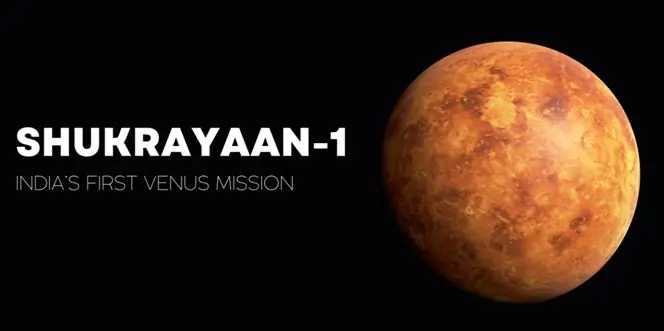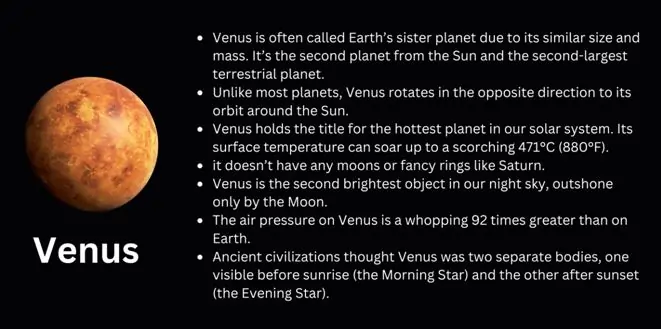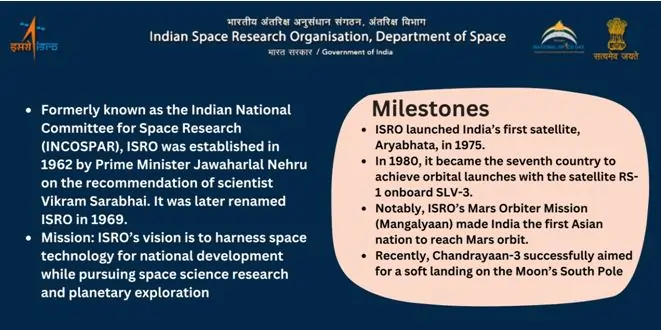
India, which recently set a record in space science by sending the Mars orbiter mission, Mangalyaan to Mars, is preparing for the second interplanetary mission to Venus. The mission appropriately named Shukrayaan-1 aims to provide valuable information about Venus’s atmosphere, its structure, and geology through the use of advanced scientific equipment. Here’s what you need to know:
Why Venus?
Venus, which is considered earth’s twin, has always fascinated the scientific community. Venus is one of the tough neighbourhoods one could imagine. It is estimated to have a near melt temperature of 130 degrees Celsius on its surface; it has a thick CO2 atmosphere and continues to have several layers of clouds. Why we are interested in Venus:
- The Hottest Planet: Venus is the hottest planet in the solar system, and Earth’s evil twin sister; temperatures on the surface are scorching, enough to fry an egg if you were to somehow transport one to the planet. Its understanding can give glimpses of the processes which can only be explained by the existence of a planet.
- Greenhouse Effect: Venus experienced what scientists call the runaway greenhouse effect, where heat spirals up through the planet’s thick atmosphere, a possible scenario for Earth in the distant future. Understanding it is important since it enables the analysis of climate change dynamics.
- Volcanoes and Quakes: It would be that there are some clues pointing towards volcanic activity on Venus. Shukrayaan-1 is meant to establish if the said volcanoes are still active and if there exists seismic-activity under its ground.

Shukrayaan-1’s Objectives
- Surface Exploration: It will assess mechanisms occurring on the Venusian surface and subsurface structure of layering. Picture a spaceship looking through deep fog to unveil the topography of this mysterious planet as a geologist would.
- Atmospheric Dynamics: The key goal of Shukrayaan-1 is to reveal the structure, composition and movement dynamics of the Venusian atmosphere. It can be compared to listen in an intergalactic dialogue between gases.
- Solar Wind Interactions: The mission will explore how the planet’s ionosphere can be affected by the solar wind, which is a flow of charged particles from the Sun. These interactions determine the state of the environment of the planet.
Key Highlights
- Launch Timeline: Earlier proposed for launch in the year 2023,ISRO’s inter-planetary mission to Venus named ‘Shukrayaan-1’ is proposed for launch in March 2028. This time is considered appropriate because while traveling there is accorded the good Earth-Venus aspect.
- Payloads: The orbiter will take about 100 Kgs of scientific instruments with it. These payloads will study interplanetary dust particles, high energy particles in Venusian environment and thermal state of the planet Venus.
- Aero-Braking Adventure: India will for the first time try to achieving aero braking system. In this context imagine the spacecraft gliding like a bird just above Venus’ upper stratosphere to decrease its orbit. Off course, it is like a cosmic ballet dance of fuel efficient.
Benefits of Shukrayaan-1
India’s first mission to Venus is represented by Shukrayaan-1. This interplanetary mission puts ISRO into the league of space agencies studying the mysterious second planet of the solar system – Earth’s twin. The potential benefits of this exploration are:
- It highlights India’s emerging technological capabilities, as part of the operative mission statement of the Country. As we plan for the launch of an orbiter to Venus, the world will be witnessing how well we design, think scientifically and manage Space mission. And so, whatever the outcome of Shukrayaan-1, it is very much more than a mere ‘Venus mission’ it is a statement of confidence in India’s ability to fashion and execute a technically demanding interplanetary mission and therefore, its potential to join the select planetary exploration societies of the world.
- The ultimate goal of Shukrayaan-1 is to demystify Venus. What is hidden under those layers of thick sulphuric acid clouds? What geologic formations are present on it? Is there volcanic activity? Through this analysis of the body and its environment it is the aim of researchers to achieve a better understanding of the environment in which Venus exists and developed in.
- The mission will use exotic scientific tools; much as synthetic aperture radar, infrared and ultraviolet cameras, and sensors. These tools will peer into Venus’s ionosphere, the density of gases in its atmosphere, and whether it is seismically or volcanically active.
- The ionosphere on Venus which is the electrically charged layer of its upper atmosphere is central to its relations with the solar wind. Shukrayaan-1 will analyse between Venus and the solar wind. Knowledge of these interactions might help to obtain useful data on the history of formation of the planet, as well as its current state.
- A few billion years ago, Earth was not the comfortable home paradise that average human sees it today. Specifically, the analysis of the Venusian conditions that may have become different allows one to look at the evolution of the Earth. Shukrayaan-1 may detect similar or dissimilar patterns of planetary formation and help shed a floodlight on the great cosmic soap opera by which our corner of the galaxy was sculpted.

Challenges to study Venus
- Extreme Heat: Venus Franking Conditions Even the metal lead wouldn’t want to be a solid in Venus due to the very high surface temperatures. With an average surface temperature of about 465 degrees Celsius or 869 degrees Fahrenheit, it is hot up there.
- Atmospheric Pressure: Having a pressure of 92 times the Earth’s atmospheric pressure. Picture this: You are 1 mile under water but there are no grains of sand, no schools of colourful fish, no serene blue water instead you have a thick soupy material overhead this is how it feels on surface of Venus.
- Acidic Atmosphere: The Dangers of Sulphuric Acid Cloud Venus does not only have clouds, but sulphuric acid clouds. Acid can damage many things so its difficult to send instruments on surface to study.
- Volcanic Activity: Venus is infested with volcanic activities and is not merely a desolate land. On its surface feature is created by large areas of flat land resulted from volcanic eruptions, numerous, steep volcanic cones.
History of Venus Exploration
Venus, the closest planet to the Earth, has always attracted much attention of scientists and space organizations. It’s dense with an atmosphere, intense heat and the notorious leading clouds make it hard to explore. Here’s a glimpse into the remarkable missions that have ventured toward this sulphurous inferno:
Mariner 2 (1962)
The first spacecraft which was successful in its travel to another planet beyond the Earth was Mariner 2 which was designed by NASA-US. On 14th of December 1962 it made an accomplished flyby of Venus, the data it collected involved information on Venus’ atmosphere and the surface.For some time, people dreamt that it was as comfortable as Earth, but Mariner 2 demonstrated that on the planet, it is incredibly hot and pressurized.
Pioneer Venus 1 (1978)
Pioneer Venus 1 gave the US its first orbiter mission to Venus. It analyses the planet’s atmosphere, and it was able to collect significant data as to the planet’s atmospheric makeup and movements.
Magellan (1989)
Breakthrough: Magellan, introduced by NASA to the Venusian exploration, unveiled the hydrological map of the planet to a great extent. Using radar imaging it painted the entire surface and it found vast volcanic plains, highlands and enormous impact basins.Whereas Magellan had airborne radar that could ‘see’ through the equally cloudy weather of Venus.
Venus Express (2005)
European Endeavour: The European Space Agency mission, Venus Express was conducted putting the spacecraft into orbit around Venus. It investigated its atmosphere, including cyclone, and volcanic exercise.A giant double vortex was directly observed by the Venus Express – a whirl that periodically occurs in the planet’s South Pole’s atmosphere.
UPCOMING MISSIONS
- DAVINCI: Future Mission: As for Venus, NASA has its DAVINCI that will study Venus in its upper atmosphere, to its surface. It will also examine the make-up and decode the tale of Venus.
- VERITAS: Mapping Venus: VERITAS: (Venus Emissivity, Radio Science, InSAR, Topography, and Spectroscopy) will make a topographic model of Venus, and this model will let us study its geological activity and tectonics.
- EnVision (ESA, Planned): 2030s Vision: Organism: EnVision An ESA mission to Venus will allow for the study of Venus history, climate, geo processing. It has said that it will unlock further information about the world’s still unknown history.
Venus vs. Earth: A Cosmic Contrast
Atmosphere
- Venus: It is known that Venus is characterized by a dense and suffocating atmosphere, in addition, the amazingly hot layer has a greenhouse effect that only continues to intensify. It consists of ninety-six and a half percent of carbon dioxide and several clouds of sulphuric acid. These clouds are made to shine by reflecting the sunlight hence the brightness of Venus.
- Earth: As it is well-known, the Earth has a colourful atmosphere, with nitrogen dominating over it (about 78%) and oxygen making up about 21%. Such a flexible combination is provided the chance to live, for this reason, Earth’s atmosphere is labelled as breathable.
Surface Conditions
- Venus: The rock and soil of what is visible is of Venus is a substantial degree less forgiving than even the surface of Mars. They work at high temperature – up to 900F or 475C – which melts lead and the very high pressure, like at 900 meters deep sea. Evidently, it’s rocky surface characterised by volcanoes, extensive plains, and impacts craters.
- Earth: To we find life bustling in our home. Continents, ocean, mountains and valleys make geographical territory unique and challenging. Crust of the earth is undergoing dynamic process of tectonic activities, erosional and weathering processes.
Rotation and Day-Night Cycle
- Venus: One oddity is that Venus rotates on its axis in an opposite direction compared to most planets; that is, in the clockwise direction. The sidereal day of Venus is longer than its year, which is known as the time that the planet takes to complete one orbit around the Sun.
- Earth: We have a 24 hour day because we rotate in a counter clockwise manner. Provided we did have an axial tilt, we get seasons, the rhythm of life is therefore wonderfully predictable.
Magnetic Fields
- Venus: Interestingly, Venus possesses no considerable world magnetic discipline. This opens up its atmosphere to the solar wind which gradually erodes it of hydrogen and helium.
- Earth: Its protective magnetic field keeps dangerous solar rays from stripping our atmosphere and thereby enables life to exist.
Water and Oceans
- Venus: Sadly, Venus is bone-dry. It is likely that it does contain water but any that it did have must have dried up through evaporation resulting from heat.
- Earth: Our seas occupy roughly 71% of the Earth’s face and are home to an astounding variety of species. Water supports life, helps to control global climate and defines the physical geography of the planet with its features.
Temperature Extremes
- Venus: It’s the hottest planet; in fact, it is hotter than Mercury, even if it is located further from the Sun.
- Earth: Our atmosphere and the distance from the Sun give us a nice range of temperatures.